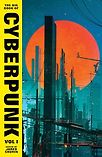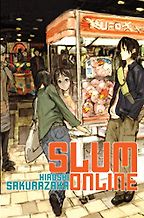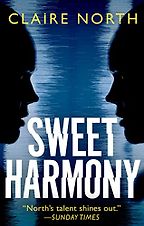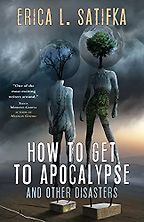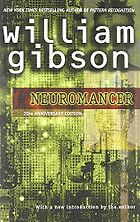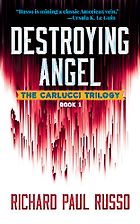You’ve written that cyberpunk is a ‘land of definitional opportunity’. Could you give us your definition?
Cyberpunk is a fascinating genre, and unlike many other genres, we know exactly when and where it started. We can see the first use of the word and the first examples that came together in the mid-1980s.
My personal definition for cyberpunk is literature about the impact of technology on the pace and scale of human affairs. There is a ton to unpick in that. What do I mean by humans? What is pace and scale? What are human affairs? But ultimately, what separates cyberpunk from other books and other genres in this space is that it’s not about the ‘how’ of technology, or the ‘what’ of technology, or even about the ‘why’ of technology. It’s about the second-order effects. Technological change is happening, or has happened, so what does that mean for everyday life and for broader society? And it’s absolutely fascinating.
The easy comparison I make is that if traditional science fiction is about flying to Mars and how we do that, cyberpunk is arguing about the playlist for the journey.
Your first choice is a foundational text for cyberpunk: please tell us about William Gibson’s Neuromancer.
Neuromancer came out in 1984 from the astounding Canadian author, William Gibson. It’s a heist novel. It’s set in a somewhat plausible near future with corporates and AI and cybernetics; where you access the internet through virtual worlds, and where everything is interlinked in a fascinating, rich, really well-developed world. That is why Neuromancer is immensely fun.
Why Neuromancer is immensely important is that Gibson builds this incredible, rich, robust world – but he doesn’t really linger on the technological details. We don’t really know how any of it works, and he doesn’t bother explaining any of it. It just is. Instead, the book is about what it’s like to live in a world like this. How do you exist? What does it mean for your relationship with other people? How do you love? How do you work? How do you belong, or have a sense of agency in a world that is this permeated with technology? And because he focuses on the emotional impact of all of it, Neuromancer has never gone out of date – which is kind of amazing for a book from 1984 that predated our modern internet world. It’s still as relevant and powerful and deep and resonant as it always was, because it’s about that feeling – that sense of being surrounded by and dominated by technology – rather than the operational details of the technology itself.
The first volume of your cyberpunk anthology opens with a Gibson short story. Could you tell us a little about his wider work and influence?
Gibson was, and remains, the central figure in cyberpunk. It’s one of the few modern genres where you can point to something substantial and say, “Here’s when and where it began” – and it was Neuromancer. One of the reasons that he’s so important is that he straddles both the worlds that go into cyberpunk: the post-modern fiction movement that was going on at the time, as people on that side of the literary fence tried to grasp everything that was happening in the world around them; and then the change in science fiction after the New Wave, as writers foresaw the impact of personal computing and globalization, and were trying to adapt science fiction stories to account for that context. Gibson created a body of work that both high-falutin’ literary critics and convention-going science fiction fans could see value in. Both could say, “I see the future in that.”
And above all of that, he’s just really good. He’s an absolutely amazing writer. His short story, The Gernsbeck Continuum, I love because it is an ode to a future that we never had. It looks at all of the things that we were promised in the middle of the 20th century when the future felt wide open and we thought everything was going to be all glossy and shiny and beautiful. And the story asks the question, “Where’s my jet pack? Where’s my meal in pill form? Where are all of those wonders I was promised?” It’s not dystopian about it – it doesn’t say that we live in some sort of horrible hellscape. It’s just a wistful, poignant look at all the futures that didn’t develop, and all the paths we didn’t take.
Let’s talk about your next choice, the first in the Carlucci trilogy: please introduce Destroying Angel, by Richard Russo.
One of the recurring questions about cyberpunk is, didn’t it end in the 80s? Does cyberpunk still even exist today? Is it still relevant at all? The five books I’ve chosen are deliberately tracking cyberpunk through the ages up to now, to prove its continued relevance. So our trip to the early 90s is Richard Paul Russo’s Destroying Angel.
This is a noir thriller in a near-future San Francisco, where a dissolute policeman is tracking down a serial killer. Cyberpunk and noir go hand in hand. They are often conflated. I think that’s probably because they both have a lot of rain and cities in them. I think the real parallel is that they’re both genres where the themes are often mistaken for the aesthetic and vice versa. Destroying Angel is actually one of the few moments where the centre of the Venn diagram is perfect: it is a brilliant piece of cyberpunk and it is undeniably noir.
It’s incredibly claustrophobic and suffocating, and it’s within a collapsing system. Despite being set in a world where space travel exists, you can just feel the walls start to collapse around you. Like Neuromancer, it creates a fully realized, entirely plausible, but just a little bit weird world, which feels a tiny bit out of reach in the future, and it talks about how ordinary people try to thrive and survive.
It’s absolutely soul-destroying. It will break your heart. But it is a terrific, incredibly tense thriller, and also great cyberpunk.
Again, we’re in a world that, while not a pure dystopia, is grim… What’s the appeal of these bleakly realist worlds?
Yes, cyberpunk takes place in difficult worlds. These stories really push the bounds of what we think of when we think about escapism, and they’re very rarely heroic. But there’s a challenging plausibility, I suppose. They allow us to look at what lies ahead, and use fiction as a sandbox to build emotional resilience, and prepare us for the worst – or possibly best – eventualities.
It is important to note that cyberpunk worlds have that element of hope in them. Even Neuromancer, if you’ll pardon the spoiler, has a happy ending. A broken world isn’t magically healed, but there’s a sense of healing and progress at smaller, more personal levels. That possibility of change, amongst other things, is what prevents cyberpunk worlds from ever becoming pure dystopia.
If there’s one theme that goes throughout cyberpunk, it’s the relationship between humanity and technology, but it is about the persistence of humanity as well. However overwhelming or pervasive or robust these technological systems are, there’s always that spark of human life and humanity’s ability to challenge; the glorious randomness of human nature. So in a weird way, however bleak or despairing these worlds are, humans still prevail and challenge and resist. They’re a sort of survivor fiction in that way.
Cyberpunk worlds always have the possibility of change in them, and that might be small and local and personal, or that might be global and epic, but there is always that spark of hope.
Your third choice is a Japanese novel: Slum Online, by Hiroshi Sakurazaka – we’re now in 2010.
Sakurazaka is also the author of All You Need to Kill, which was filmed as The Edge of Tomorrow. Slum Online was first published in 2005, which was a year after – and this is relevant – World of Warcraft. It’s about a young man, a student in Japan, who spends a lot of his time playing a massive multiplayer online game called Versus Town. It’s essentially a virtual world where everyone is a martial artist and beats the crap out of one another. It seems really fun, honestly.
Again, it’s not about how Versus Town – this big complex global virtual world – works. It’s about its impact on this young man’s life.
Slum Online treats the game with respect. It shows – in a way that’s very prescient, when we think about where we are in 2025 – how the online world and the offline world have equal weight, equal importance, equal emotional and almost physical impact on his life.
It is a ‘light’ novel. Not a lot happens. It follows our guy as he tries to meet a nice girl and goes exploring his city in the offline world. Online, he is trying his best to win a martial arts competition. He’s trying to achieve success, and it encourages the reader to think about what that success means. Is it successfully holding down his first relationship, graduating from his college program, or winning this tournament? They’re all meaningful to him – it’s about that search for meaning.
There’s a casual acceptance to the way this book treats its virtual world. It just is. It’s important. It absorbs his life and those of other characters. It can be incredibly seductive and addictive, but it can also be empowering and give a sense of friendship and belonging and connection. When we think about where we are now, and what we know now about how video games work, as the largest pastime in the world, and how we connect with them… This was an incredibly smart piece of cyberpunk that saw this coming very early on the road, and writes about it in an emotionally powerful way that’s equally relevant twenty years later.
I was interested to see a piece in translation on your list – is cyberpunk very global?
Yes, very much so. The core themes – how do we relate to technology? How does it impact our lives? – are global, and the movement has been global from its very early days. From the mid-1980s, you see cyberpunk works appearing throughout Latin and South America, through Russia and Eastern Europe, France, Japan, South Korea… Really everywhere.
That’s because everyone, wherever you are, is facing a technological revolution or change that is relevant to you. We’ve seen technology spread and expand, and new technology comes from all different parts of the world. Cyberpunk is one artistic or cultural way of dealing with that change.
As an aside, I was disappointed that I couldn’t find short fiction to include by Sakurazaka for the anthology. He actually wrote a short story as a follow-up to Slum Online, which is a really, really great piece of fiction – but it makes absolutely no sense unless you’ve read Slum Online. I’m glad to be able to talk about this great piece of cyberpunk that I couldn’t include in the book.
The Big Book of Cyberpunk is certainly global – some pieces were translated into English especially for the book, for the first time. How did you even begin the editorial process of making the selections?
I was really lucky. I speak English mostly (barely!). Once I had my definition of cyberpunk, the core notion of how The Big Book was going to define it, I briefed a network of translators, of friends, of authors I know around the world, and writers and journalists and even a filmmaker, and I said, “Tell me what you’ve seen that’s like this.” And some amazing work came back.
I wasn’t able to include all of it, of course, but I was introduced to some amazing authors and artists and creators from around the world. We were able to get at least a few representative examples. We were able to include some of those seminal works from Mexico and from Russia, for example, that hadn’t been previously translated into English. And a relatively new story from South Korea… It was really important to showcase these, because cyberpunk is inherently global, and we needed all of the perspectives that the book could possibly contain. I can’t remember the final number, but there are over two dozen countries represented – which is still only scratching the surface.
And you structured the choices around how tech impacts four aspects – the self, culture, system, and challenge…
The framework is slightly different for the UK and US editions. Although the stories are the same, the order is a little different, just to keep everyone on their toes. But yes, the book is structured around the way that technology impacts the pace and scale of human affairs, so I needed to devise a way of dividing ‘human affairs’. So, what does tech mean for the individual and our individual identity? What does it mean for culture – the way that we look at art, or read, or eat, or play sports? Cyberpunk is a kind of soft science fiction in that it takes cultural impact seriously, which is brilliant. It also considers those broader layers of human affairs as well – how we connect with one another, and with a greater sense of society.
Those ideas are very clear in your next choice… Tell us about Claire North’s Sweet Harmony.
Sweet Harmony is a novella, currently digital-only. The title character, Harmony, lives in the near future where everyone is completely infused with nanotech of some unspecified sort. By paying a bit for upgrades, you can give yourself that little boost. If you need a good hair day, if you need to be a little sharper, if you want nice, even teeth, if you want to be a bit fitter or more clever… hit the button! Set up that monthly withdrawal, and wham, you’re that little bit better.
Harmony is a completely ordinary person. The book walks us through the addictive nature of subscriptions and microtransactions and how easy it is to get caught in a cycle like this. We see the dangers of it – of selling a little bit of yourself to distant corporate overlords, one piece at a time, who are going to act like they’re working in your best interest. But at the end of the day, the instant you can’t make a payment is the instant that your teeth fall out.
Again, Sweet Harmony doesn’t really linger on how the technology works or why; it looks at the day-to-day experience of living in this tech-infused space, and what that means to you psychologically. And, also, what it means socially. In a world where you can have all of these benefits at the click of a button, what does it say if you’re someone who doesn’t? What is it like to have these optimisations on tap and then lose them, or lose them and then have them again? It’s really powerful and incredibly scary.
Sweet Harmony is only a few years old, but already we’re starting to see things like Elon Musk brewing up brain implants. Right after, there was a story revealing what happened when people with cochlear implants lost their hearing when their software was no longer supported. Technology is amazing, it’s wonderful, it’s powerful, it can make all of these changes, but there’s a risk in being forced to outsource part of yourself to a greater system that doesn’t care about individual wellbeing in the way that it should.
I didn’t know that about the cochlear software. I’ve worked with folks using that tech, that really brings the reality home…
This was an ongoing, very interesting conversation that I was having while putting The Big Book together. Early cyberpunk was ableist; it was so suspicious of technology that any sense of a ‘cyborg’ was wrong. If anyone needed or wanted modifications for any reason, a lot of that cyberpunk fiction made it seem ethically dubious, assuming there was an intrinsic loss of humanity that came from adding anything cybernetic.
Sweet Harmony is much more balanced: you can see that this technology does help people. It’s important, it can make a really positive change in people’s lives. It’s not the tech that’s bad, it’s the system in which the tech exists. There’s no judgment here about having nanotechnology that can clear up your skin – much less fix a heart problem. The judgment is reserved for the corporations that attach that benefit to a subscription model to ransack your savings. That nuance is important, and I think Sweet Harmony handles it well.
Your last choice brings us right up to 2021: How to Get to Apocalypse and Other Disasters (2021) by Erica Satifka.
How to Get to Apocalypse is a collection of short fiction by Erica Satifka, whose work is all over the internet, but she pulled it all together for this book, including a couple of new stories. You’ll find all sorts of things in there, from alien invasions to long explorations of redundancy…
The way I’d describe it is that if cyberpunk never existed until right now, and someone said, “Start from scratch, just look at the technology around you with no knowledge of the genre or its tropes. Don’t respond to anything that’s existed before you, and only look at where we are in this moment”… You would get this book. It is a little hyperbolic to call it the Neuromancer of 2021 – but it is a defining text for where cyberpunk is right now. It’s beautiful and it’s haunting and it’s about people, but in a world where, again, the technology has been robustly integrated into the system of the way people live. What does that mean for our jobs? What does that mean for our relationships? What does it mean for your sense of self and your identity?
There’s a really powerful story in here, “Act of Providence”, about a woman who goes through a harrowing near-death experience and is one of the few survivors. She makes a deal to share her story so it can be recreated as an immersive virtual experience. It is part artistry, part disaster tourism. But does that memory still belong to her anymore? Who owns the copyright of her feelings, of her experience, now? When technology can create something so powerful, that makes these questions all the muddier.
Some of Satifka’s stories are very small and focused, but they’re all very human and very powerful. They look at where we are going based on the trajectory we’re on right now. It originates in the here and the now. It’s also completely devoid of that aesthetic that goes through cyberpunk – there’s no neon, no rain. It’s a 2021 look at cyberpunk that is completely untarnished by anything that went before.
Your anthology ends with a post-cyberpunk section. In true cyberpunk spirit, could you give us a glimpse of where we’re going next?
According to various experts – and there are many amazing experts in cyberpunk – the genre ended at any point between 1985 and now. Cyberpunk is awash with people who supposedly killed it. One of the corresponding notions that resulted from this mass murder was the idea of post-cyberpunk: if cyberpunk is dead, what are we reading now? What’s come after it? And like cyberpunk, there are lots of definitions for whatever ‘post-cyberpunk’ is.
I fundamentally disagree with the premise because I think cyberpunk itself is still relevant and thriving and doing incredibly well, if more diffusely. But within the book, I’ve baked up a spurious definition of post-cyberpunk, which is anything that mostly meets my rules for cyberpunk; something that’s 80% cyberpunk and shows how cyberpunk itself can be a platform for even more types of story. Maybe it has a non-human protagonist, or is set a bit further in the future, or isn’t grounded in a plausible technology, but everything else is still, for lack of a better term, ‘cyberpunk-y’.
Cyberpunk has become more mainstream – it now permeates all sorts of other genres and ways of thinking. I think we’re in a world where lots of things are 80% cyberpunk, and that post-cyberpunk approach, which pays homage to its cyberpunk roots, is useful.
Right now, probably one of the best examples is the Pulitzer Prize-shortlisted Vauhini Vara and her short piece Ghosts, which she essentially co-writes with an AI. That feels like it’s an accusation – because a lot of people are co-writing with AIs in a really bad way – but what Vara does is use almost-first-generation AI as a way of dealing with the loss of her sister, and to try to give voice to her feelings. She writes about that experience, rather than handing the AI the pen, per se. I think that’s a really good example of post-cyberpunk, of thinking about technology as part of the process of feeling, as well as being. I love this story, but it made me cry and cry. I’ve not forgiven it yet.
Interview by Sylvia Bishop
May 26, 2025. Updated: October 3, 2025
Five Books aims to keep its book recommendations and interviews up to date. If you are the interviewee and would like to update your choice of books (or even just what you say about them) please email us at [email protected]
Five Books interviews are expensive to produce. If you've enjoyed this interview, please support us by donating a small amount.

